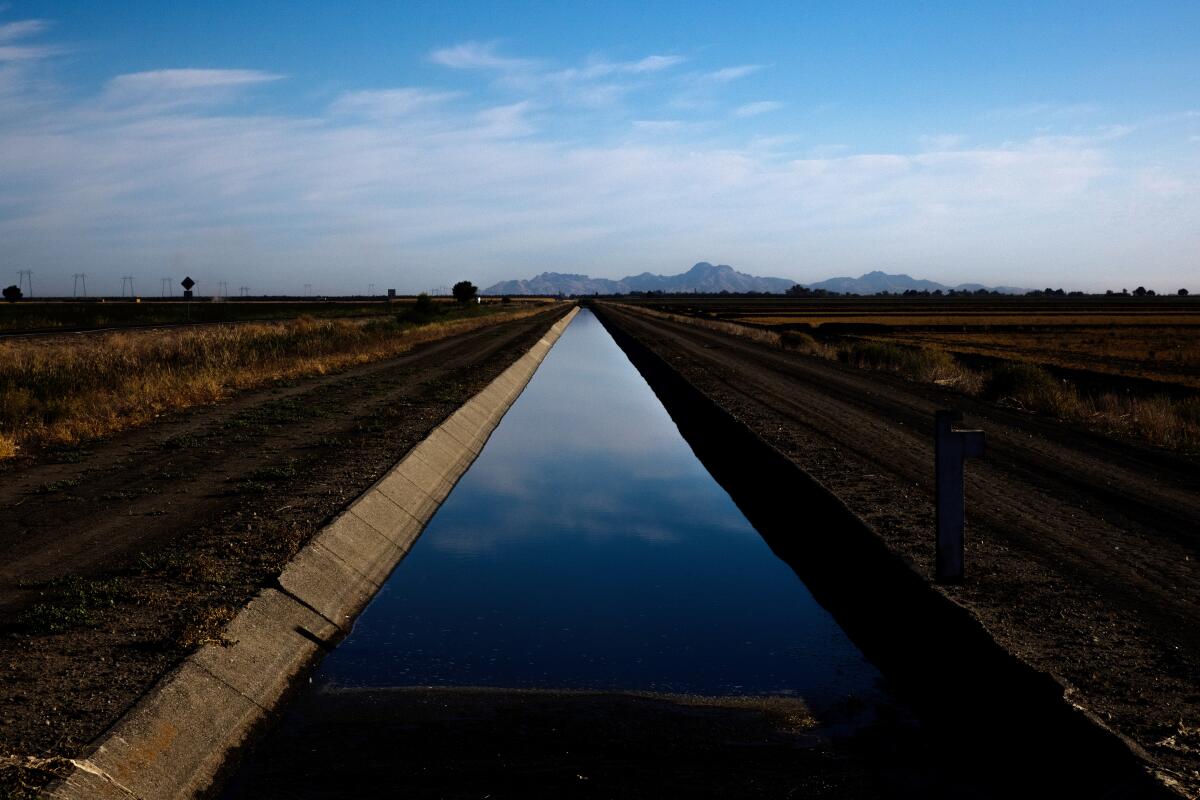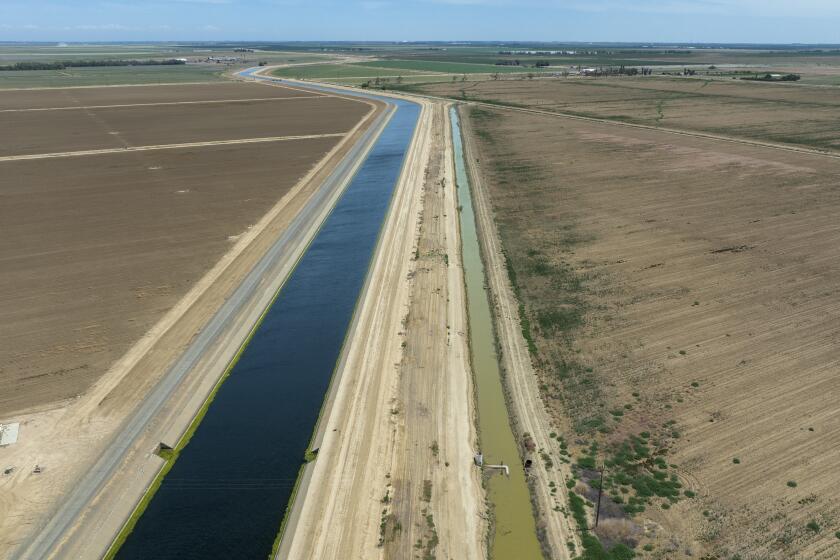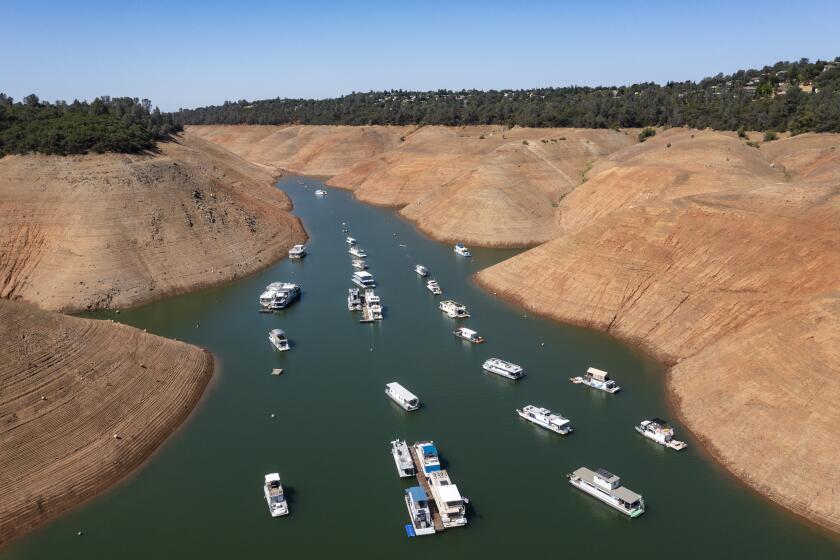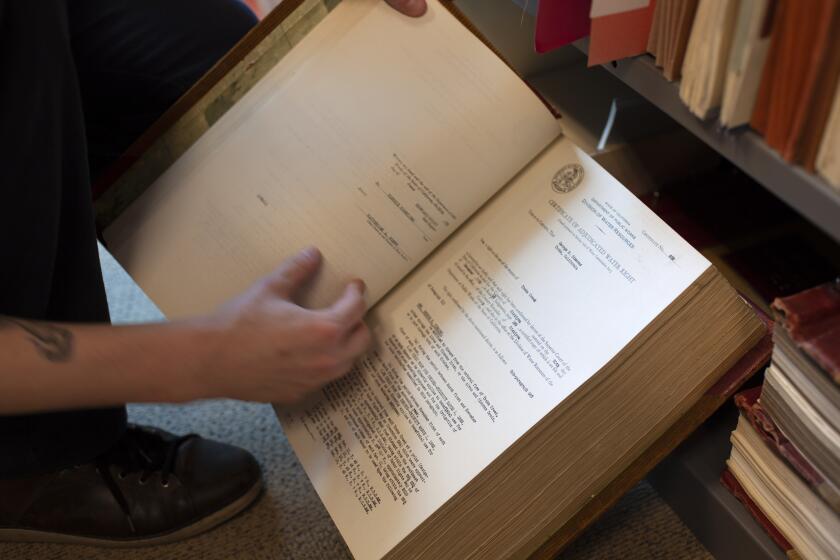‘Improvised, spotty and belated’: Will California reform its oversight of water rights?

- Share via
California’s complex system of water rights took shape starting in the mid-1800s, when settlers saw the state’s water as abundant and free for the taking — a time when a Gold Rush prospector could stake claim to river flows simply by nailing a notice to a tree.
Today, California’s oldest and most senior water rights — called riparian and pre-1914 rights — have been passed along to thousands of agricultural landowners, irrigation districts and urban water suppliers that claim control of roughly one-third of the water that is diverted from the state’s rivers and streams.
But increasingly, California water regulators are struggling to manage supplies for 39 million residents, agriculture and the environment as climate change warps the hydrologic cycle and brings longer-lasting and more severe droughts. Legal experts say the way the state manages this antiquated system is in dire need of reform. Among other problems, they say, current law prevents officials from verifying whether claims of senior water rights are valid, ordering those water users to reduce usage, or imposing fines that are large enough to penalize those who flout the rules.
Three bills gaining momentum in the Legislature are seeking to change that, even as they draw heated opposition from water agencies and agricultural groups.
As calls mount to reform California’s antiquated water rights system, some are calling on lawmakers to address the system’s legacy of racism.
“These bills show that the Legislature is taking a serious look at bringing more comprehensive and consistent regulation to water rights — and empowering the State Water Resources Control Board to do the job California needs it to do,” said Nell Green Nylen, a senior research fellow at the UC Berkeley School of Law’s Wheeler Water Institute.
Green Nylen is part of a group of legal experts who recently published a state-funded report outlining recommendations for legislative and policy changes to improve oversight and management of the water rights system. She said the bills in the Legislature would partially address some of their recommendations, while still leaving some “concerning gaps in the state’s ability to manage water scarcity.”
One bill — AB 1337, introduced by Assemblymember Buffy Wicks (D-Oakland) — would clarify that the State Water Board has authority to issue a curtailment order for all diverters, including senior rights holders. The legislation was drafted in response to a recent decision by an appeals court, which sided with water agencies in the Sacramento-San Joaquin River Delta that had challenged the state’s authority to order cuts. In its decision, the court suggested it’s up to the Legislature to determine whether it’s time to update the law.
Another measure approved by the Senate, SB 389, would give the State Water Board the authority to investigate and verify whether the claims of senior rights holders are valid and accurate.
“They’ve got to have more tools at their disposal to better understand the rights system as it exists,” said Sen. Ben Allen (D-Santa Monica), who introduced the proposal.
California’s existing water rights allocate far more water than is available in an average year, Allen noted, and state water regulators are tasked with making the system work through increasingly intense droughts.
The change would help the water rights system function the way it’s supposed to, “before we run out of time to fix it,” Allen said.
Another bill, AB 460, would strengthen the State Water Board’s enforcement powers to stop illegal water diversions and would sharply increase fines for violators.
The bill is intended to prevent the sort of violations that occurred in August in the Shasta River watershed, when farmers and ranchers who belong to the Shasta River Water Assn. defied a curtailment order for eight days and diverted more than half the river’s flow, flouting requirements aimed at protecting salmon. The State Water Board fined the association the maximum amount for the violation: $4,000, which worked out to about $50 for each of its members.
The case led to widespread calls for larger fines and stronger enforcement powers.
‘We are in a time of crisis’: Experts launch effort to update California water laws in the face of climate change and historic injustices
“If we have scofflaws out there taking water that is not theirs, then it really messes up the entire system,” said Assemblymember Rebecca Bauer-Kahan (D-Orinda), who introduced the bill.
The bill would give the State Water Board the authority to issue temporary orders to stop the illegal taking of water, and would increase fines for violations to up to $10,000 per day, plus $2,500 per acre-foot of water diverted. (An acre-foot is 325,851 gallons, or enough to cover one acre a foot deep.)
Some environmental groups and tribes have called for a major overhaul of the state’s water rights, arguing that the current system was built on a foundation of violence against Native people, the taking of land from tribes, and systemic racism that long prevented people of color from securing water rights.
Supporters of the reform proposals in the Legislature say the bills aren’t meant to radically change the existing system, but rather to make a dysfunctional system work.
“These modest changes are a first step in retrofitting the water rights system for the 21st century challenges ahead,” said Amanda Fencl, a senior climate scientist for the Union of Concerned Scientists. She said the measures offer critical updates to enable the State Water Board “to make informed and timely water management decisions and build climate resilience for the future.”
The proposals are facing opposition from many water agencies and groups representing the agriculture industry.
The three bills “all create increased uncertainty in the water supply, which would make it harder for growers to plan — and could result in fewer planned acres of food grown,” said Gail Delihant, senior director of California government affairs for Western Growers, which represents more than 1,500 crop growers, packers and shippers.
Delihant said the measures represent “attempts to destabilize the water rights system in California.”
Also opposing the bills is the Assn. of California Water Agencies, or ACWA, which represents about 460 public agencies that deliver water to cities and farms. Kristopher Anderson, a legislative advocate for ACWA, said the bills “present a foundational change in the way California’s water rights system is implemented, managed, and enforced.”
“They would authorize the State Water Board to impose punitive penalties on even law-abiding water right holders, curtail water rights in any year, and strip entities of their water rights,” Anderson said. “This package of legislation would create significant uncertainty, and lead to unintended consequences, for not just water right holders themselves, but communities and businesses across the state that depend on a reliable water supply.”
Anderson said water agencies that belong to the association agree that higher fines are necessary to deter violations, such as those that occurred on the Shasta River last year. But he and other opponents argued the proposal is overly broad and goes beyond what is necessary.
California’s reliance on an antiquated system of recording water rights is hampering the state’s ability to respond to drought, experts say.
In a letter opposing Wicks’ bill, representatives of dozens of water districts and agriculture industry groups said they support proposals to “modernize administration” of the water rights system by improving how the state collects and manages data, and by deploying more stream gages, among other steps. They argued that as it stands, the proposal “threatens to remake the way water rights are managed in California by employing a top-down approach that would override decades of successful collaborative water management practices.”
State officials are working on a project to modernize California’s water rights information system by digitizing about 7 million pages of paper records. But officials have said that even those extensive records in many cases don’t include original documents that show proof of pre-1914 water rights, which were grandfathered in under the 1913 Water Commission Act. That act established a permit process for rights from then on.
In a February meeting, state officials said there are currently about 2,600 riparian and pre-1914 water rights claims in the San Joaquin River watershed, and more than 3,900 rights claims in the Sacramento River watershed. The rights are held by various entities and individuals, among them agencies that supply cities and agricultural irrigation districts supplying farms that produce nuts, cotton, rice and other crops.
In their recent report, Green Nylen and other water law researchers recommended various changes to establish what they say would be a fair and effective framework for curtailing water rights. They said that the Legislature should clarify, among other things, that the State Water Board has broad authority to order curtailments for all diverters, including those with the oldest rights.
The researchers said the State Water Board “needs to implement curtailments on a regular basis, not only in times of extreme crisis or only in certain watersheds.” They noted that other Western states routinely curtail water rights in this way.
“Drought response has been improvised, spotty and belated,” said Dave Owen, a professor at UC College of the Law in San Francisco.
“If you talk to people at the board, they will bluntly tell you they’re incredibly frustrated with their inability to gather information that they think they need. And then there are anemic enforcement mechanisms,” Owen said. “We just have this huge mismatch between major problems, big expectations for the agency and a fairly weak set of implementation tools. And it just means that we sort of default to the status quo. We default to improvisation or we default to letting people just kind of do what they want with water — unless it is so egregiously obvious that there is a problem that we have to step in.”
Michael Kiparsky, director of the Wheeler Water Institute at the UC Berkeley School of Law, said it’s vital that state officials look ahead now to improve how the system functions to respond to the next drought.
“Our system for water administration in California just doesn’t work,” Kiparsky said. “It doesn’t work because the state doesn’t have the tools it needs to do the basics. Those basics include figuring out who should have the right to divert water from rivers and streams at any particular time, and telling those who should not be diverting water that they can’t. It’s a very basic function.”










